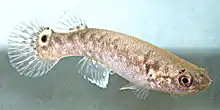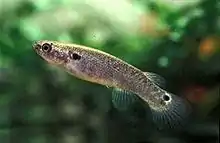Mangrove rivulus
The mangrove killifish or mangrove rivulus, Kryptolebias marmoratus (syn. Rivulus marmoratus),[3] is a species of killifish in the family Rivulidae. It lives in brackish and marine waters (less frequently in fresh water) along the coasts of Florida, through the Antilles, and along the eastern and northern Atlantic coasts of Mexico, Central America and South America (south to Brazil).[1][2] It has a very wide tolerance of both salinity (0—68 ‰)[4] and temperature (12–38 °C or 54–100 °F),[5] can survive for about two months on land,[6] and mostly breeds by self-fertilization.[7] It is typically found in areas with red mangrove and sometimes lives in burrows of Cardisoma guanhumi crabs.[5]
| Mangrove rivulus | |
|---|---|
 | |
| Scientific classification | |
| Kingdom: | Animalia |
| Phylum: | Chordata |
| Class: | Actinopterygii |
| Order: | Cyprinodontiformes |
| Family: | Rivulidae |
| Genus: | Kryptolebias |
| Species: | K. marmoratus |
| Binomial name | |
| Kryptolebias marmoratus (Poey, 1880) | |
| Synonyms[2] | |
| |
The mangrove rivulus is up to 7.5 cm (3.0 in) long,[2] but most individuals are 1–3.8 cm (0.4–1.5 in).[4]
Overall the mangrove rivulus is widespread and not threatened,[1] but in the United States it is considered a Species of Concern by the National Marine Fisheries Service.[8]
Ecology
Land living
The mangrove rivulus can spend up to 66 consecutive days out of water, which it typically spends inside fallen logs, breathing air through its skin.[6] It enters burrows created by insects inside trees where it relaxes its territorial, aggressive behavior. During this time, it alters its gills so it can retain water and nutrients, while nitrogen waste is excreted through the skin. The change is reversed once it re-enters the water.[6]
When jumping on land, the mangrove rivulus does a "tail flip", flipping its head over its body towards the tail end. The rivulus' jumping technique gives it an ability to direct its jumps on land and to make relatively forceful jumps. A team of scientists associated with the Society for Experimental Biology released a video in 2013 showing the jumping technique.[9]
Breeding

Spawning has not yet been observed in the wild in the mangrove rivulus, but captive studies show that the eggs are positioned in shallow water, sometimes even in places that periodically are on land during low tide. The eggs can continue their development when out of water, but once they are ready to hatch this is delayed until again submerged.[10][11]
The species consists mostly of hermaphrodites which are known to reproduce by self-fertilization, but males do exist,[7] and strong genetic evidence indicates occasional outcrossing.[12] They are also the only simultaneous hermaphroditic vertebrates, and the concentration of males to hermaphrodites can vary depending on the local requirement for genetic diversity (for example, if an increase in the local parasite population occurred, secondary male numbers might increase).[13] In Florida, almost all (>99%) are homozygous clones, but in highly colonized South and Central American pools males typically are 3—8% of the population, and in offshore cays in Belize 20—25% are males.[5]
K. marmoratus produces eggs and sperm by meiosis and routinely reproduces by self-fertilization. Each individual hermaphrodite normally fertilizes itself when an egg and sperm that it has produced by an internal organ unite inside the fish's body.[14] In nature, this mode of reproduction can yield highly homozygous lines composed of individuals so genetically uniform as to be, in effect, identical to one another.[15][16] The capacity for selfing in these fishes has apparently persisted for at least several hundred thousand years.[17] Meioses that lead to self-fertilization can reduce genetic fitness by causing inbreeding depression. However, self-fertilization does provide the benefit of “fertilization assurance” (reproductive assurance) at each generation.[15] Meiosis can also provide the adaptive benefit of efficient recombinational repair of DNA damages during formation of germ cells at each generation. This benefit may have prevented the evolutionary replacement of meiosis and selfing by a simpler type of clonal reproduction such as ameiotic or apomictic parthenogenesis. Adults may cannibalize juveniles, but only unrelated offspring.[18]
Conservation
Overall the mangrove rivulus is widespread and not threatened,[1] but in the United States it is considered a Species of Concern by the National Marine Fisheries Service.[8] It is considered a species of Least Concern by the IUCN,[1] and was formerly listed as a species of special concern in Florida, but has since been delisted.[4] It was formerly often overlooked and considered rare in Florida, but surveys have revealed that it is locally common in this state and abundant in the Florida Keys.[1] It is considered vulnerable by the American Fisheries Society.
The mangrove rivulus is considered to have potential as a bioindicator species of estuary habitats.[1]
References
- NatureServe & Lyons, T.J. (2019). "Kryptolebias marmoratus". IUCN Red List of Threatened Species. 2019: e.T19735A131005753. doi:10.2305/IUCN.UK.2019-2.RLTS.T19735A131005753.en.
- Froese, Rainer and Pauly, Daniel, eds. (2019). "Kryptolebias marmoratus" in FishBase. April 2019 version.
- Ong, K. J.; Stevens, E. D.; Wright, P. A. (2007). "Gill morphology of the mangrove killifish (Kryptolebias marmoratus) is plastic and changes in response to terrestrial air exposure". Journal of Experimental Biology. 210 (7): 1109–15. doi:10.1242/jeb.002238. PMID 17371909.
- Bester, C: Mangrove Rivulus. Florida Museum. Retrieved 6 May 2017.
- Hill, K: Rivulus marmoratus. Smithsonian Marine Station at Fort Pierce. Retrieved 6 May 2017.
- "Tropical fish can live for months out of water", Reuters, Wed Nov 14, 2007 9:05pm GMT
- Lublnski, B. A.; Davis, W. P.; Taylor, D. S.; Turner, B. J. (1995). "Outcrossing in a natural population of a self-fertilizing hermaphroditic fish" (PDF). Journal of Heredity. 86 (6): 469–473. doi:10.1093/oxfordjournals.jhered.a111623.
- National Marine Fisheries Service (23 February 2017). Species of Concern List. Retrieved 6 May 2017.
- Tail-Flipping Fish Hops on Land on YouTube
- Taylor, D.S. (2012). "Twenty-four years in the mud: what have we learned about the natural history and ecology of the mangrove rivulus, Kryptolebias marmoratus?". Integrative and Comparative Biology. 52 (6): 724–736. doi:10.1093/icb/ics062. PMC 3501094. PMID 22576816.
- Martin, K.L.; A.L. Carter (2013). "Brave new propagules: terrestrial embryos in anamniotic eggs". Integrative and Comparative Biology. 53 (2): 233–247. doi:10.1093/icb/ict018. PMID 23604618.
- MacKiewicz, M.; Tatarenkov, A.; Turner, B. J.; Avise, J. C. (2006). "A mixed-mating strategy in a hermaphroditic vertebrate". Proceedings of the Royal Society B: Biological Sciences. 273 (1600): 2449–52. doi:10.1098/rspb.2006.3594. PMC 1634907. PMID 16959634.
- Cole, Kathleen S.; Noakes, David L. G. (1 January 1997). "Gonadal development and sexual allocation in mangrove killifish, Rivulus marmoratus (Pisces: Atherinomorpha)". Copeia. 1997 (3): 596–600. doi:10.2307/1447566. JSTOR 1447566.
- Sakakura, Yoshitaka; Soyano, Kiyoshi; Noakes, David L.G.; Hagiwara, Atsushi (2006). "Gonadal morphology in the self-fertilizing mangrove killifish, Kryptolebias marmoratus". Ichthyological Research. 53 (4): 427–430. doi:10.1007/s10228-006-0362-2. hdl:10069/35713. S2CID 9474211.
- Avise JC, Tatarenkov A (November 2012). "Allard's argument versus Baker's contention for the adaptive significance of selfing in a hermaphroditic fish". Proceedings of the National Academy of Sciences of the United States of America. 109 (46): 18862–7. doi:10.1073/pnas.1217202109. PMC 3503157. PMID 23112206.
- Earley RL, Hanninen AF, Fuller A, Garcia MJ, Lee EA (December 2012). "Phenotypic plasticity and integration in the mangrove rivulus (Kryptolebias marmoratus): a prospectus". Integrative and Comparative Biology. 52 (6): 814–27. doi:10.1093/icb/ics118. PMC 3501102. PMID 22990587.
- Tatarenkov A, Lima SM, Taylor DS, Avise JC (August 2009). "Long-term retention of self-fertilization in a fish clade". Proceedings of the National Academy of Sciences of the United States of America. 106 (34): 14456–9. doi:10.1073/pnas.0907852106. PMC 2732792. PMID 19706532.
- Wells, Michael W.; Wright, Patricia A. (2017-10-01). "Do not eat your kids: embryonic kin recognition in an amphibious fish". Behavioral Ecology and Sociobiology. 71 (10): 140. doi:10.1007/s00265-017-2360-y. ISSN 0340-5443. S2CID 34001850.
External links
| Wikimedia Commons has media related to Kryptolebias marmoratus. |
